Southlands Almanac - June 2025
Australian Capital Region
Wheel & Cross is proud to publish this monthly Almanac at the start of each month. It was created to observe and understand the cycle of seasons in the Australian Capital Region, through the lens of European agricultural knowledge and publicly available and openly shared knowledge of the traditional custodians of ‘Capital Country’, the Ngunnawal.
I acknowledge that the Ngambri people also claim custodianship of these lands. Unfortunately, I do not have any Ngambri cultural information regarding language, connection to Country or seasonal customs. This means I am unable to share anything relating to Ngambri culture but I am always keen to learn.
I pay my respects to all First Nations Elders, past and present and to all First Nations peoples from around Australia and the Torres Strait Islands who are the proud custodians of this Country we all love.
Contents
Important Dates in June
Ngunnawal Season - Magarawangga (Deep Winter)
Weather and Climate
Weather Summary - May
Regional Water Storage - May
June and Winter Long-range forecast
Star Gazing and Star Lore
Moon phases - Winter or Frost Moon
Visible planets, meteors and solar movements
Western and First Nations ‘star lore’ - Pleiades
Nature and Environment
Useful weeds - Mallow
Native flora - Grevillea
Native fauna - Echidna
In Season - seasonal crops, flowers and food
Important Dates in June
Source: Department of Home Affairs - Calendar of cultural and religious dates and Wheel & Cross Seasonal Celebrations Digest for June
1 June - Holle’s Day
1-3 June - Shavuot (Jewish)
3 June - Mabo Day (Australian)
6-10 June - Eid al Adha (Muslim)
8 June - Pentecost (Christian)
4-9 June - The Hajj (Muslim)
15-21 June - Refugee Week (Australian)
20 June - World Refugee Day (Global)
20 June - Matariki (New Zealand)
21 June - Mother’s Night/Modranicht (Winter Solstice - Southern Hemisphere)
27 June - Al Hijri (Islamic)
Holle’s Day - 1 June

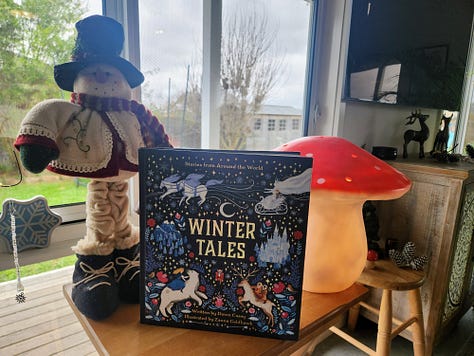

June 1st marks the beginning of winter across Australia and New Zealand, making it the perfect time to honour Frau Holle—also known as Holda or Mother Hulda—a revered winter spirit from German folklore. Known as a weather goddess, a guardian of fertility, and a protector of women’s household crafts, Frau Holle is said to shake out her featherbeds to bring snow. In some tales, she rides the winter skies in a chariot or sleigh, blessing the fields below as she passes. Celebrate the start of the winter season by adorning your home with wintry touches, embracing the Danish art of hygge, and enjoying warming food and drinks.
This month’s Wheel & Cross Seasonal Celebrations Digest for June is brimming with insights into the history and traditions of European winter festivals, along with creative ideas to help you celebrate the season.
Shavuot - 1-3 June (Jewish)
Shavuot is a Jewish celebration of Moses’s descent from Mount Sinai with the Ten Commandments. It is the second of the Jewish pilgrim festivals. Some Jews refrain from working on Shavuot.
Mabo Day - 3 June (Australian)
The Australian High Court delivered the Mabo decision on 3 June 1992, providing legal recognition that Indigenous people have a special relationship with the land. This decision paved the way for land rights known as native title. Mabo Day celebrates the life of activist Eddie Koiki Mabo.
Eid al Adha - 6-10 June (Muslim)
Eid al Adha means Feast of Sacrifice and commemorates the ordeal of Ibrahim (Abraham), who was asked to sacrifice his only son to prove his faith to Allah (God). Muslims around the world celebrate Eid al-Adha with communal prayers, sacrifices of livestock, feasting, charitable giving, and the sharing of meat. The timing of this event is subject to the sighting of the moon, and runs for three to four days.
Pentecost - 8 June (Christian)
Pentecost is a Christian festival that commemorates the gift of the Holy Spirit to the apostles. It falls on the Sunday that comes fifty days after Easter. The name “Pentecost” comes from the Greek word pentēkostē, meaning “fiftieth.”
Hajj - 4-9 June (Muslim)
Hajj is the annual Islamic pilgrimage to Mecca, and one of the Five Pillars of Islam. Every able-bodied Muslim who can afford it is expected to undertake this spiritual journey to Mecca in Saudi Arabia, the Prophet Muhammad’s birthplace, at least once in their lifetime. It involves a series of sacred rituals over five days, including walking around the Kaaba (the house of Allah), standing in prayer on the plain of Arafat, and symbolic acts of purification and renewal.
Refugee Week - 15-21 June (Australian)
Refugee Week is celebrated around the country. It is an opportunity to acknowledge the success of refugees and humanitarian entrants in Australian society.
World Refugee Day - 20 June (Global)
This day honours refugees and celebrates the strength and courage of people forced to flee their home country to escape conflict or persecution.
Matariki 20 June (New Zealand)
Matariki is a New Zealand national holiday to celebrate the first rising of the Pleiades star cluster. This marks the beginning of the new year in the Māori lunar calendar. You can learn more about Matariki in the section below about the Pleiades constellation.
Modranicht (Mother’s Night) - 21 June (Winter Solstice)
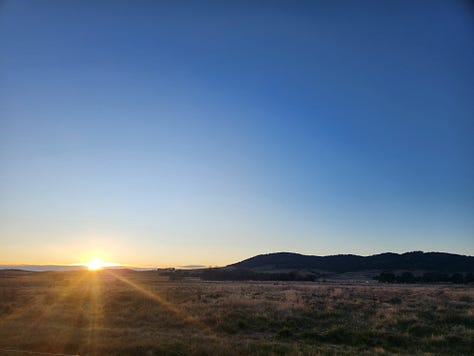
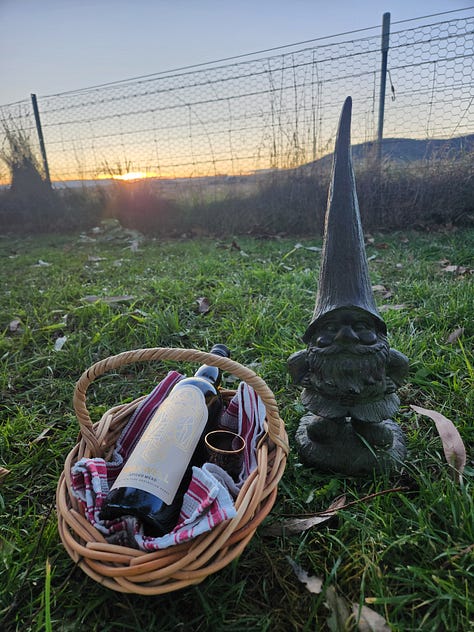

The Winter Solstice marks the longest night and the turning point of the year, when the sun begins its slow return. Across ancient cultures, this time was seen as sacred—a moment to honour the life-giving, protective forces of the feminine.
In the deep past, the Reindeer Mother Cult of Ice Age Eurasia venerated the female reindeer as the mother of all life on earth, especially the herds and the reindeer people, and a guide through darkness. This tradition is echoed in the surviving Sámi culture of the Arctic tundra. Across Europe, deer cults and solstice goddesses symbolised renewal and ancestral wisdom.
The Celts honoured the Cailleach and the rebirth of the sun, while the Ancient Romans celebrated Saturnalia with feasting and gift-giving. In Germanic lands, the solstice was known as Modranicht, or Mother’s Night—a time to honour female ancestors and the spirits of hearth and home.
This month’s Wheel & Cross Seasonal Celebrations Digest for June is brimming with insights into the history and traditions of European winter solstice festivals, along with creative ideas to help you celebrate the season.
Al Hijri - 27 June (Islamic)
According to the lunar or Islamic Calendar, Al Hijri (Al Hijrah in Arabic) is the Islamic New Year observed on the first day of Muharram and commemorates the Prophet Muhammad’s migration (Hijra) from Mecca to Medina. Muslims observe this day with quiet reflection, prayer, and recitation of the Qur'an, rather than with festive celebrations. Muharram is the Islamic Calendar’s first month of the year and is the second-holiest month after Ramadan.
Ngunnawal Season - Magarawangga (Deep Winter)
Sources: Tyronne Bell, Ngunnawal Elder, Thunderstone Cultural Aboriginal Services
The Australian Capital Region is part of the Southern Tablelands. It has a cool temperate climate featuring warm to hot and dry summers and cold winters with heavy frosts and radiation fog.
June ushers in the second half of the Ngunnawal season of Magarawangga—deep winter. This time of year is characterised by heavy fogs and sharp frosts, which will persist through to August. Snow begins to dust the Brindabella Ranges and settles more deeply across the Australian Alps and Snowy Mountains. As the chill sets in, early-flowering wattles brighten the landscape with splashes of yellow and cream. It’s also breeding season for echidnas, which is explored further in the next section.
In the ACT and across New South Wales, traditional firestick management—also known as cultural burning—is typically carried out during the cooler months of late autumn and early winter. This practice, guided by First Peoples’ knowledge systems, involves the careful, low-intensity burning of selected areas to manage vegetation, reduce fuel loads, promote ecological regeneration, and support biodiversity. Unlike broad-scale hazard reduction burns, cultural burns are smaller, slower, and tailored to the specific needs of the landscape, often timed according to the growth cycles of native plants and the lifeways of local fauna. Winter provides the safest and most effective window for these burns, as the land cools and moisture returns with the seasonal shift. Performing this ancient custom also renews the connection between First Peoples, culture and Country.
Weather and Climate
Sources: Australian Bureau of Meteorology, WeatherZone.com.au, Timeanddate.com, Weather Spark, Weather Atlas
Under the Köppen climate classification system, Canberra’s climate is classified as Cfb, denoting a temperate oceanic climate characterised by warm summers, moderate winters and minimal rainfall differences between seasons.
Weather Summary - May
After a dry and unusually warm autumn driven by persistent high-pressure systems and disrupted north-south cloud bands, southern Australia finally saw a shift in atmospheric patterns in the middle of May. The highs that dominated throughout most of autumn, weakened or moved eastward, allowing low-pressure systems and cold fronts to push up from the Southern Ocean once more. This brought much-needed rainfall to parts of the ACT and New South Wales. However, a separate coastal low intensified off the NSW coast, drawing in moisture from the Tasman Sea, leading to large rainfalls and causing flooding north of Sydney. In contrast, South Australia remains in the grip of drought. While some areas, such as Kangaroo Island and the Fleurieu Peninsula, received modest rain, key agricultural regions saw minimal precipitation, far from enough to ease dry conditions.
Soil moisture in the south and west of the Australian Capital Region was below average to well below average, while in the north and east of the country was above average or well above average. Soil moisture in the Australian Capital Region remained average for May.
Max Temp - The average maximum temperature for May this year was 18.2°C, higher (1.7°C) than the long-term average of 16.5°C. The highest maximum temperature was 23.6°C recorded on 7 May.
Min Temp - The average minimum temperature for April this year was 3.8°C, higher (1.4°C) than the long-term average of 2.4°C. The lowest minimum temperature for the month was -3.9°C recorded on 30 May.
Rainfall - It rained over 1mm on 6 days in May, with 2 days receiving less than 1mm for a total of 40.4mm, substantially more than the May average of 3.9 days and 33.4mm of rain. The highest amount fell on 23 May with 19.6mm of rain.
Water Storage - May
Water storage levels are mixed across the Murray-Darling Basin. Storage levels in west and northern NSW and southern QLD are high due to recent heavy rain events, while in the southern regions, water levels are well below average.
Water for the Australian Capital Territory and Queanbeyan in NSW is stored in four dams across two water catchments, managed by Icon Water. These include Corin, Bendora, Cotter and Googong. Storage levels in Canberra are at 90.59% (251.96 GL of 277.84 GL).
Queanbeyan Palerang Regional Council has an agreement with Icon Water to purchase potable water for the Queanbeyan area. The villages of Braidwood, Bungendore, and Captains Flat have their own water treatment facilities for bore water, which serve the urban area of the three towns/villages. Bungendore has reached its water sustaining capacity, and options for a pipeline from Queanbeyan are currently being explored.
Goulburn-Mullwaree Council supplies water to Tarago and Lake Bathurst from the Pejar Dam (9,000 ML), Sooley Dam (6,250 ML), and Rossi Weir (330 ML) via the Goulburn Water Filtration Plant and the Highland Source Pipeline.
The Upper Lachlan Shire Council manages water supply to Gunning via pumping from the Lachlan River into a storage dam (100 ML), then into town through a water treatment facility. No information is available on storage levels. Collector relies on untreated water from rooftop rain collection and local bores.
Water for the Yass Valley Council region, including the town of Yass, and villages of Bowning, Binalong and Murrumbateman, is supplied from the Yass Dam (2,460ML and 15,000 pax capacity). Recent rain increased its capacity to 95.16%. Gundaroo relies on untreated water supplies from rooftop rain collection and local bores.
June Weather Forecast
Australian Bureau of Meteorology
The weather normally continues to cool in June with average high temperatures dropping to 13.2°C and average lows dropping to 1.1°C. Frosts and fogs are common. Rain over 1mm usually falls for an average of 6.1 days, with 47.9mm of accumulated precipitation.
Current weather forecasts predict above-average chances of rain across most of mainland Australia, though the Australian Capital Region is predicted to receive an average chance of rainfall over winter. Temperatures are expected to remain well above average throughout June, with an increased chance of unusually warm day and night temperatures. However, cold spells and frosts are still possible.
Sea Surface Temperatures (SSTs) around Australia are expected to remain higher than average. The El Niño Southern Oscillation (ENSO) and the Indian Ocean Dipole (DMI) are forecast to stay neutral.
Long-range Forecast
The Australian Bureau of Meteorology has released its long-range forecast for June to August 2025.
Star Gazing and Star Lore
Sources: Time and Date, Scitech, Australian Indigenous Astronomy,
Lunar Phases
Tuesday, 3rd - First Quarter Moon (waxing) - Rise 12:35 pm E, Set 12:16 am W (4th)
Wednesday, 11th - FULL MOON (Winter or Frost Moon)* - Rise 4:31 pm SE, Set 8:01 am SW (12th)
Wednesday, 18th - Last Quarter Moon (waning) - Rise 11:50 pm E, Set 12:13 pm W (19th)
Wednesday, 25th - New Moon - Rise 7:02 am NE, Set 4:25 pm NW
*The names of the full moons provided here generally correspond with names used in old English agricultural calendars and similar American Almanacs, although they have been rearranged according to their appropriate season in the southern hemisphere. See Full Moon Names for the Southern Hemisphere for more information.
Stars, Planets and Meteors
Not all stars in the night sky are scientifically stars. True stars comprise the vast number of what we call ‘stars’. They appear to twinkle as their light comes from active suns in distant solar systems. The other celestial bodies we call ‘stars’ are planets in our solar system, visible from Earth. They shine steadily in the night sky rather than twinkle as they steadily reflect the sun’s light, rather than producing their own light.
MERCURY - is lost in the glare of the Sun in the first couple of weeks of June, but in the second half of the month, it can be seen up to an hour after sunset in the northwestern sky.
VENUS - the ‘Morning Star’ is particularly bright in the northeastern sky just before dawn.
MARS - is visible in the evenings in the northwest sky. It is moving through the constellation of Leo and by June 17 can be seen in close approach with Regulus, the brightest star in Leo.
JUPITER - is not visible in the sky until early July.
SATURN - is visible with a telescope in the eastern sky before dawn, sitting slightly higher than Venus.
METEORS - no meteor showers are visible this month.
Constellation Feature - Pleiades
Each year in mid to late June, just before dawn, a small cluster of stars rises in the eastern sky, marking one of the most significant celestial events of the Southern Hemisphere’s winter season. Known globally as the Pleiades and in Aotearoa New Zealand as Matariki, this star group reappears after weeks of invisibility behind the sun’s glare, in a moment known as the heliacal rising. For many cultures around the world, the reappearance of the Pleiades has long marked a time of renewal, remembrance, and preparation for the new season ahead.
In Western astronomy, the Pleiades are classified as an open star cluster in the constellation Taurus, located approximately 440 light-years from Earth. Known since antiquity, the Pleiades are referenced in texts from Greek, Roman, and even Biblical sources. In Greek and later Roman mythology, Orion was a great hunter who became enamoured with the Pleiades, seven sisters and daughters of the Titan Atlas and the sea-nymph Pleione. To escape his persistent pursuit, the sisters fled across the earth. In response to their pleas, Zeus transformed them into stars, placing them in the sky where they could be safe. Yet even in the heavens, Orion continues to chase them—his constellation rising just after theirs each night and appearing to follow them across the sky for eternity.
For the Māori people of Aotearoa (New Zealand), the heliacal rising of Matariki signals the beginning of the Māori New Year—a time to honour ancestors, reflect on the past, and set intentions for the coming year. Each star within the Matariki cluster carries its own meaning, connected to different aspects of the natural world, such as food from the land (Tupuānuku), fresh water (Waitī), salt water (Waitā), and sky (Tupuārangi). Though its public recognition was long suppressed under colonisation, Matariki has been revitalised in recent years and is now a national public holiday.
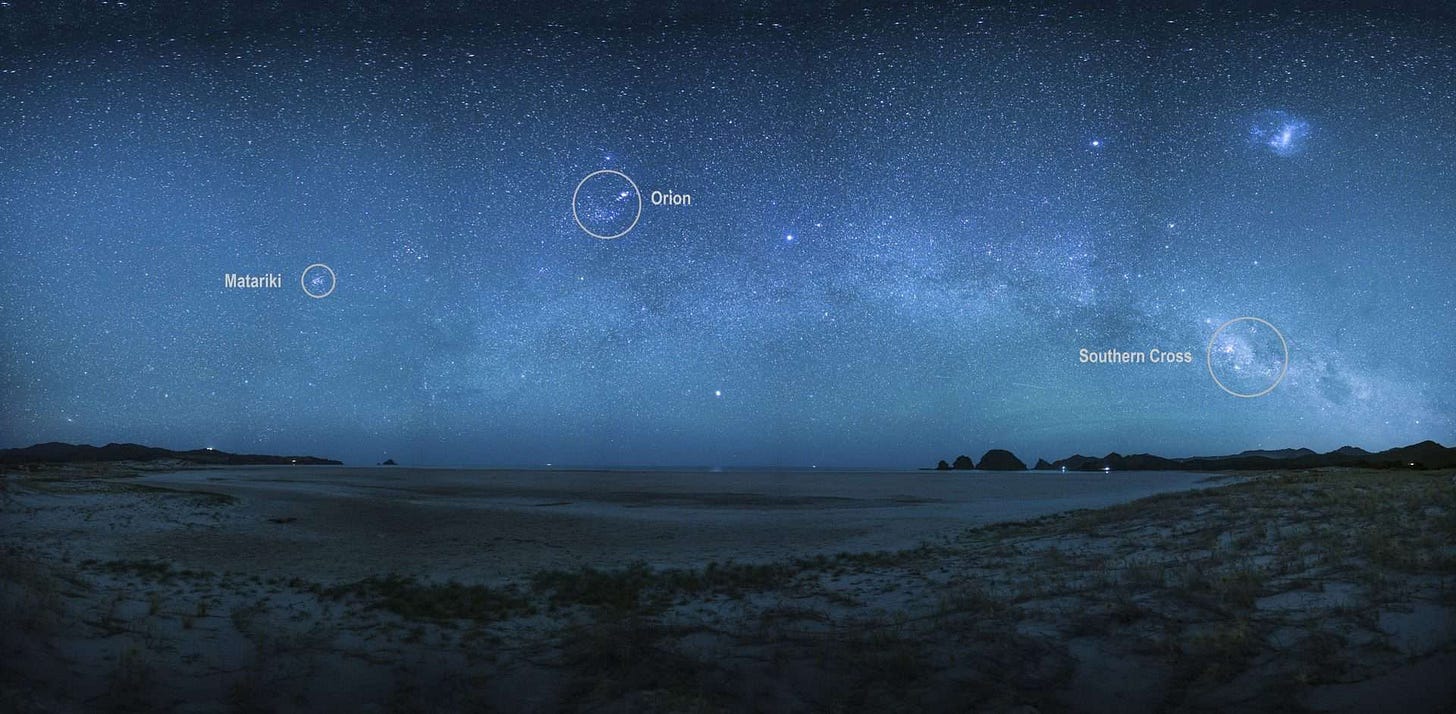

The video (1:50 mins) below will help you locate Matariki in the June night sky:
For Australia’s First Peoples, the heliacal rising of the Pleiades is equally significant, though each Nation tells its own story. Many traditions mirror ancient Greek and Roman mythology, recognising the cluster as a group of ancestral women, known collectively in some regions as the Seven Sisters, who are pursued across the land and sky by a male figure, often identified with the Orion constellation. This story forms part of a widespread and ancient songline, linking sacred geography to the stars. The reappearance of the Seven Sisters in June often signals a time for fire management, food gathering, and ceremony, aligning cultural responsibilities with seasonal changes on Country.
In Wiradjuri Aboriginal traditions of central New South Wales, Baiame is the creation ancestor, seen in the sky as Orion - nearly identical in shape to his Greek counterpart. Baiame trips and falls over the horizon as the constellation sets, which is why he appears upside down. The Pleiades are called Mulayndynang in Wiradjuri, representing seven sisters being pursued by the stars of Orion [Baiame].
In Aboriginal traditions of the Great Victoria Desert, Orion [Baiame] is also a hunter, Nyeeruna. He is pursuing the Yugarilya sisters of the Pleiades but is prevented from reaching them by their eldest sister, Kambugudha (the Hyades).
Duane Hamacher (2017), Kindred skies: ancient Greeks and Aboriginal Australians saw constellations in common, The Conversation.
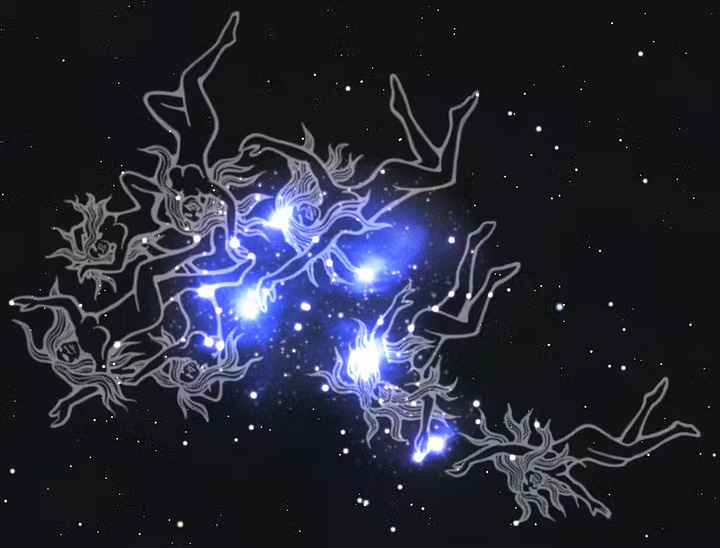
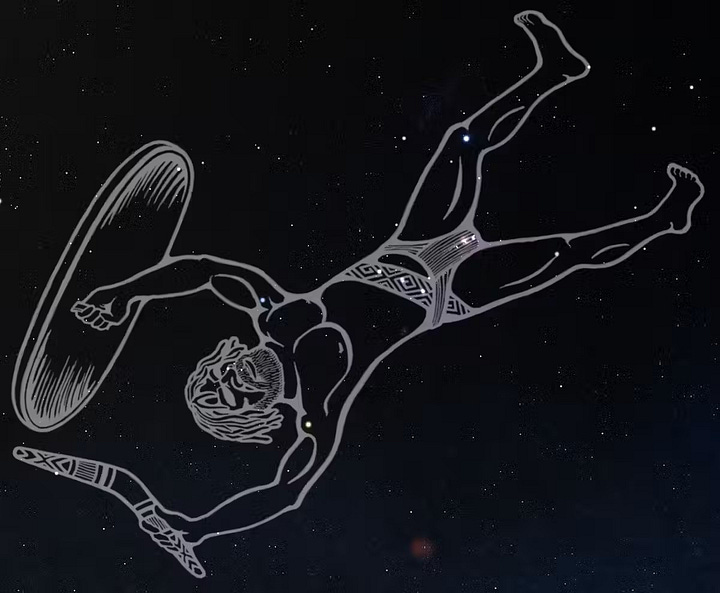
Along the east coast of Australia, the first pre-dawn appearance of the Pleiades in early June coincides with the northward migration of humpback whales from Antarctic feeding grounds to warmer breeding waters off northern New South Wales and southern Queensland. They are closely followed by orcas, who will hunt the newborn calves once the whales reach these coastal nurseries. The whales and their young, followed by the hunting Orcas, return south from September to November, peaking in October. This southbound migration is marked by the transition of the Pleiades from a morning object to a late-night one in September to the first rising of the Pleiades in the early evenings in late October.
For coastal communities such as the Gadigal people of the Eora Nation, whales are not only totemic animals but also integral to cultural ceremonies and stories. Similarly, the Yuin Nation of southern New South Wales holds the whale as a significant totem, with its migration closely observed and celebrated.
In the central desert regions, the Pleiades' reappearance signals the onset of winter and aligns with the peak breeding cycle of dingos. For the Pitjantjatjara people of the Western Desert, this period was traditionally marked by fertility ceremonies for dingos, followed by the collection of pups, which were raised as companions and, during times of scarcity, as a food source. The dingo holds profound spiritual significance across many First Nations communities, often featuring in Dreaming stories, rituals, and as a symbol of connection to Country.
As you rise early to greet the winter light, take a moment to look east. If the sky is clear, you may glimpse the Seven Sisters glinting low on the horizon.
Other Constellations
Southern Cross (Crux) - reaches its zenith and is positioned on its southwest side. More information in the January issue.
Sky Emu (Milky Way) - rising in the sky with its position changing to horizontal, indicating the male is sitting on his nest incubating his eggs, and the eggs are still available for collection. More information in the April issue.
Twins (Gemini) - no longer visible in the night sky until the start of summer. More information in the December 2024 issue.
Dog Star (Sirius) and Great Dog (Manis Major) - no longer visible in the night sky until the start of summer. More information in the February issue.
Warrior (Orion) - no longer visible in the night sky until the start of summer. More information in the March issue.
Bull (Taurus) - no longer visible in the night until the start of summer. More information in the March issue.
Seven Sisters (Pleiades) - heliacal rise in the early mornings in late June. See previous section.
Centaurus - high in the southern sky, wrapped around the Southern Cross.
Scorpius - rising higher on the eastern horizon at sunset. More information in May issue.
Sagittarius and Corona Australis - rising higher on the eastern horizon at sunset.
Aquila - rising higher on the eastern horizon at sunset.
Southern Fish (Piscis Austrinus) - not visible until its reappearance in July.
Nature and the Environment
Most of the information provided about native seasonal flora and fauna is relevant to the cool climate region in Australia’s south, particularly the Australian Capital Region, and can be found in the book, ‘Ngunnawal Plant Use: A Traditional Aboriginal Plant Use Guide for the ACT region,’ and the ‘Ngunnawal Seasonal Calendar’ by Ngunawal Elder and traditional custodian, Tyronne Bell from Thunderstone Aboriginal Cultural Services.
Useful Weeds (Food/Medicine) - Mallow
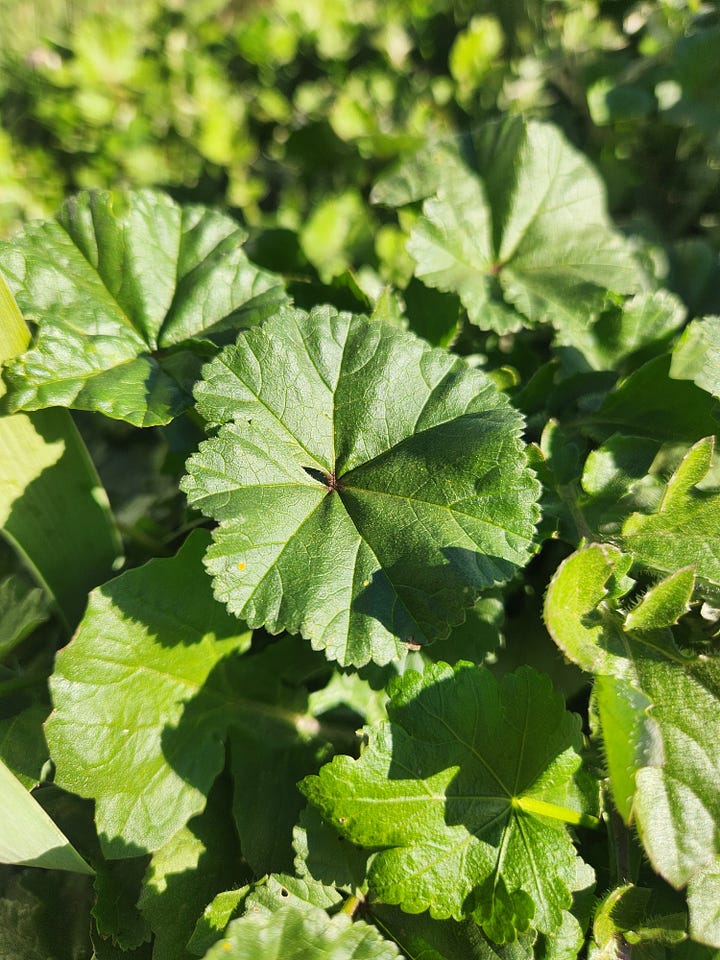
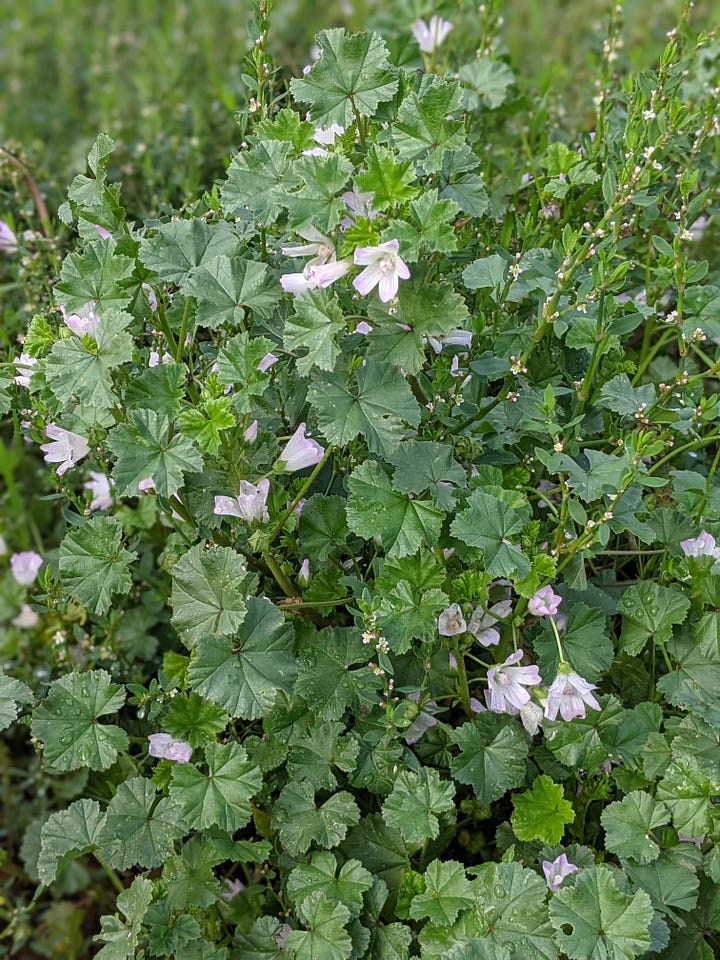
The Common Mallow (Malva neglecta) is a hardy, low-growing herbaceous plant found throughout temperate regions, including much of Europe, Asia, and naturalised in Australia. Easily identified by its rounded, scallop-edged leaves, it often forms a creeping groundcover and produces delicate, pale pink to lavender flowers with darker veining from spring through autumn. The plant’s distinctive seed pods, often called "cheeses" due to their wheel-like shape, are a favourite for foraging children. Mallow thrives in disturbed soils, along roadsides, garden edges, and wastelands—hence the Latin name neglecta, meaning “neglected” or “overlooked.”
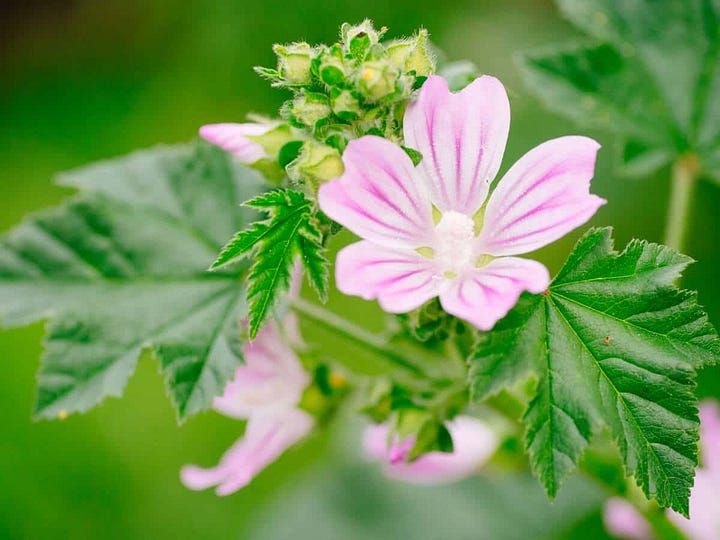
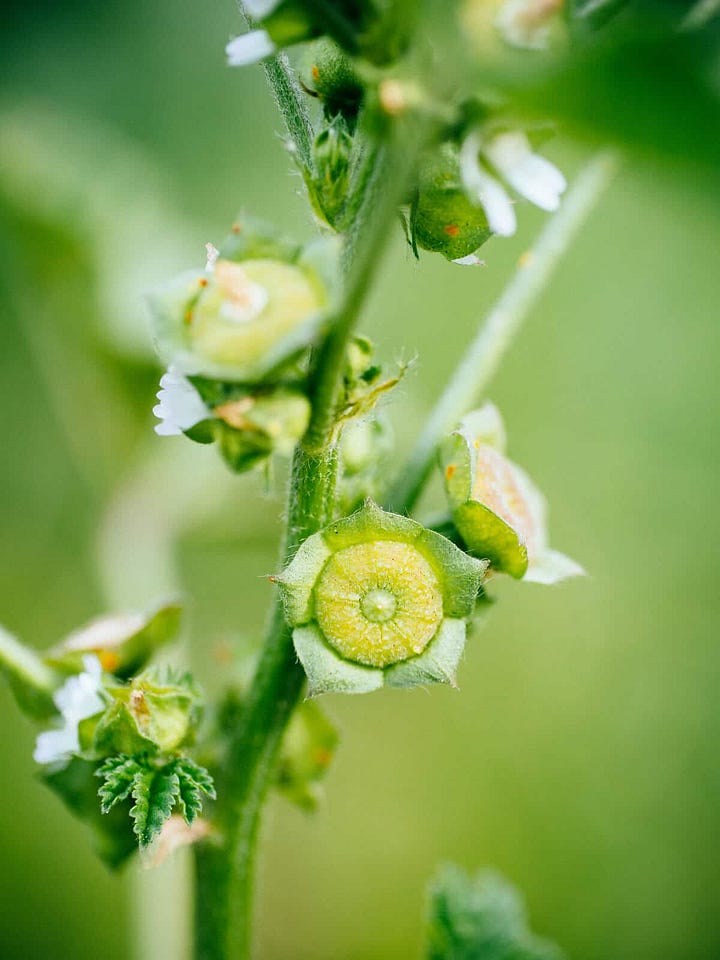
The use of mallow as a medicinal herb stretches back to ancient Greece and Rome. The Greek physician Dioscorides and the Roman writer Pliny the Elder both recommended mallow for its soothing, cooling properties, particularly in treating inflammation of the mouth, throat, stomach, and skin. It was valued as a demulcent—a plant that creates a protective, mucilaginous coating—and was commonly used in poultices, decoctions, and infusions. The Roman poet Horace is said to have subsisted on olives, endives, and mallows.
In medieval and early modern Europe, mallow held a place in both herbal medicine and magical folk practice. In parts of Britain and Ireland, it was grown in cottage gardens and used in washes and compresses for burns, stings, and swollen joints. Germanic and Slavic folk traditions often associated mallow with gentle healing and protection, sometimes planting it near doorways to guard against illness or evil. In French folklore, the plant was linked with maternal care, as it was safe for children and nursing mothers, and was sometimes woven into dream pillows to soothe restlessness or ease grief. In some areas of North Africa and the Levant, mallow soup (made from khubeza, a close relative of M. neglecta) was considered a food of resilience and survival, often cooked during times of scarcity or fasting.
Symbolically, Common Mallow has been connected with modesty, nurturing, and resilience. It was one of the “herbs of Venus” in Western herbalism, associated with gentle love and soothing the temper, both physical and emotional. Its unassuming growth habit—close to the ground, persistent, and soft—made it a favourite metaphor in poetry for the quiet strength of women, the poor, and the devout.
Native Flora - Grevillea
The Grevillea is one of Australia’s most distinctive and diverse native plant genera, encompassing over 350 species ranging from groundcovers and small shrubs to large trees. Known for their striking, often spider-like flowers in vivid shades of red, orange, pink, and yellow, Grevilleas are a defining feature of Australian bushland. They are commonly known as “spider flowers” or “toothbrush plants” for their distinctive flowers. These complex, nectar-rich blooms are highly attractive to native pollinators—particularly honeyeaters, lorikeets, and bees—and their foliage often provides shelter to small birds and insects.
Grevilleas grow in a wide range of habitats across Australia—from the dry inland mulga scrub to the coastal forests of the east and southwest, as well as the alpine areas and subtropical rainforests. While many species are adapted to nutrient-poor soils, some thrive in more fertile environments and are common in urban gardens and revegetation projects. Their resilience and spectacular appearance have also made them a popular genus in Australian native plant horticulture, where hybrids and cultivars are bred for prolonged flowering, compact form, or bird-attracting qualities.
Many grevillea species are used by Australia’s First Peoples as both a seasonal indicator and a source of nourishment. Several species, particularly those with highly visible, nectar-rich flowers, were harvested for their sweet nectar, which could be sucked directly from the flower, shaken into the hand, or steeped in water to make a sweet drink. This practice was widespread across many Aboriginal Nations, particularly in arid and semi-arid regions where sweet foods were rare. Importantly, only certain Grevillea species were used this way, particularly Honeysuckle Grevillea, Grevillea juncifolia. Other species were avoided due to the presence of cyanogenic compounds that can be harmful in large amounts, such as Silky Oak, Grevillea robusta, and Red Silky Oak, Grevillea banksii.
Beyond food, Grevilleas had cultural and practical uses. In some regions, Grevillea wood was used for tools or implements, and the appearance of flowering in certain species helped mark seasonal change or the availability of other foods. For example, in parts of Western Australia, the flowering of the red-flowered Grevillea preissii was linked with the appearance of certain fish species in local waters. Across Australia, grevilleas flowering signal the onset of cooler weather and seasonal activities for many First Nations. Grevilleas also appear in Dreaming stories and traditional ecological knowledge systems.
Native Fauna - Echidna (Tachyglossus aculeatus)
From June onwards, short-beaked echidnas (Tachyglossus aculeatus) begin their mating season, and one of the most distinctive signs of the season is the appearance of echidna trains. These are formed when a group of males follows a single female in a line, sometimes for several weeks, waiting for a chance to mate. If you're walking in bushland, rural paddocks, or even along quiet roadside verges this winter, keep an eye out for these slow-moving processions—it's one of the few times echidnas are more visible in the landscape.
The video (2:44 mins) below from National Geographic shows a ‘successful’ echidna “love train”.
Echidnas are covered in coarse fur and sharp spines, with strong digging limbs and a long, sticky tongue adapted for consuming ants and termites. Found throughout most of the Australian continent and Tasmania, they are highly adaptable and thrive in habitats ranging from arid scrub and open woodland to alpine meadows and coastal heath. Echidnas play a crucial ecological role as “soil engineers”, moving tonnes of earth each year as they burrow and forage. This activity aerates the soil, assists in water infiltration, and helps to spread seeds, making them essential contributors to the health of Australia’s ecosystems.
Among Australia’s First Peoples, echidnas hold deep cultural and spiritual meaning. Dreaming stories vary across Nations, but many describe the echidna’s transformation—how it came to bear its spines or move in its distinctive, deliberate way. In the Jaru tradition of Western Australia, the echidna once uprooted a shared shade tree in anger and was punished with spines, a lesson in balance, respect, and communal harmony. In stories from the Wunambal people of the Kimberley, the echidna’s greed is said to have led to its prickly form, teaching the importance of moderation and reciprocity in community and with Country.
In Season
Cut Flowers
Sources: Meadow and Widler Farm, What Cut Flower is That
Flowers finishing this month: None.
Flowers starting this month: Andromeda (Pieris spp.), Anemone (Anemone spp.), Button Bush (Berzelia lanuginosa), Blushing Bride (Serruria florida), Icelandic Poppy (Papaver nudicaule), Winter Rose (Hellebore spp.).
Flowers continuing this month: Goldenrods (Solidago canadensis), Heath (Erica spp.), Lavender - French (Lavandula dentata), Snapdragon (Antirrhinum majus), Violet (Viola odorata).
Kitchen Garden
Source: Food Tree, Sustainable Table
The fruit and vegetables listed below are typically harvested in June in cool temperate regions of Australia. Some are in peak condition during winter and harvested fresh at this time, while others remain available thanks to their ability to store well through the colder months. Australia’s varied climate means that seasonal produce from warmer regions also reaches markets throughout winter, giving us access to a wide range of fresh, Australian-grown fruit and vegetables year-round.
Herbs - Coriander, ginger (stored), oregano, parsley, rosemary,
Vegetables - Asian greens (bok choy, choy sum, gai laan, wombok), avocado, brussel sprouts, cabbage, cauliflower, celeriac, daikon, Florence fennel, garlic (stored), horseradish (when leaves have died back), kale, kohlrabi, leek, mushrooms, onion (stored), parsnip, potato (stored), pumpkin (stored), shallot, silverbeat, spring onion, swede, sweat potato (stored), turnip.
Fruit - apples (bonza, braeburn, cox’s orange pippins, fuji, gala, golden delicious, granny smith, jonagold, jonathan, lady williams, mutso, pink lady, red delicious, snow, sundowner), feijoa, kiwi fruit, mandarins (imperial and ellendale), oranges (blood, navel and seville), pears (beurre bosc, Josephine, packham), persimmon, quince, rhubarb, tamarillo.
If you’d like to know what to plant in the kitchen garden this month, the Canberra Organic Growers Society (COGS) website has a useful Winter Planting Guide for our region.








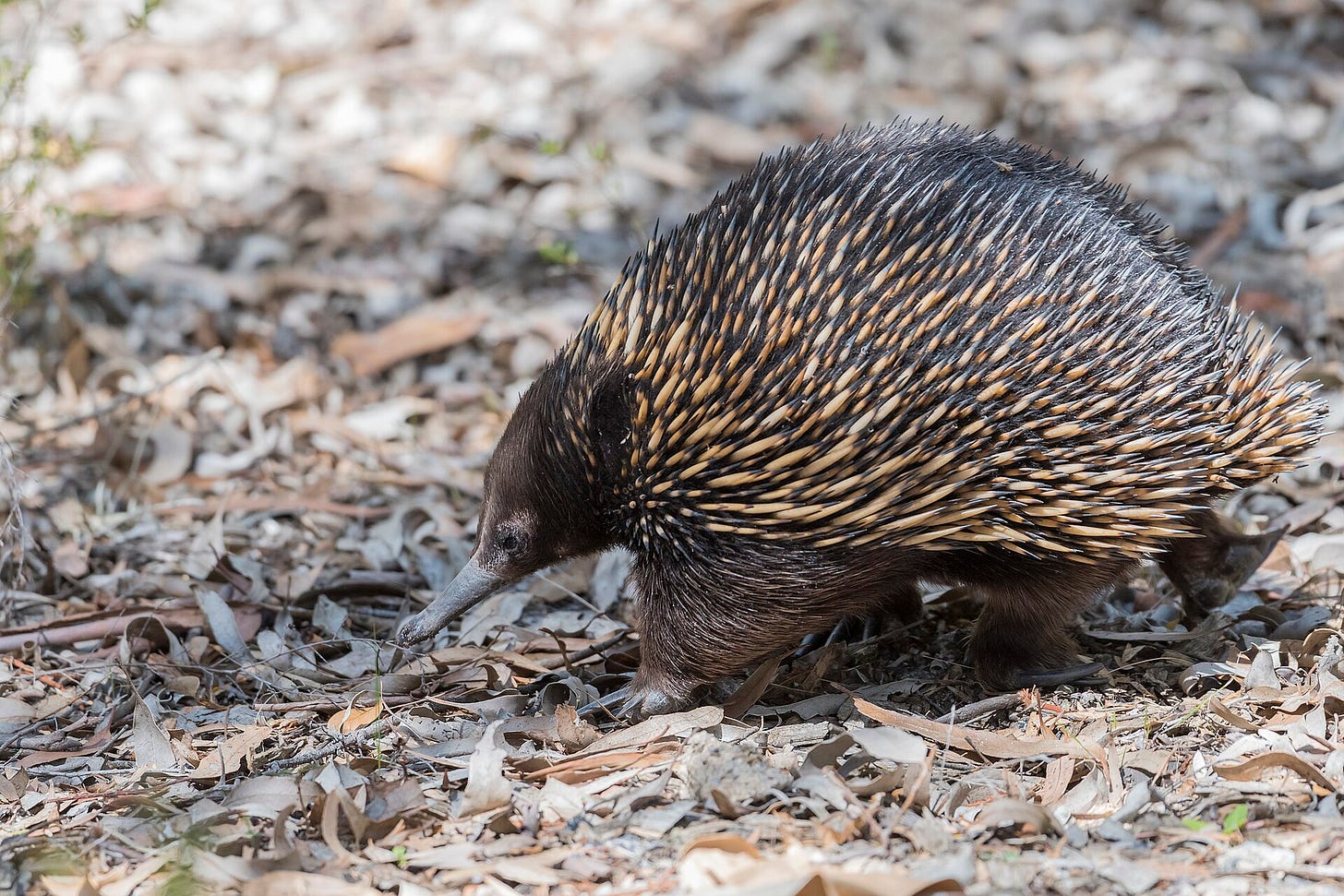
I do love poring over all this information that you gather. Thank you.
I can't believe how close we are to the winter solstice, too!
Thanks Cate, it's come around so quickly! I'm so relieved we have cold weather; Autumn was too hot for ease of mind.